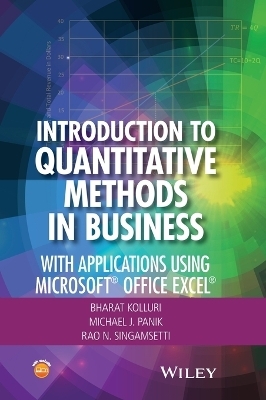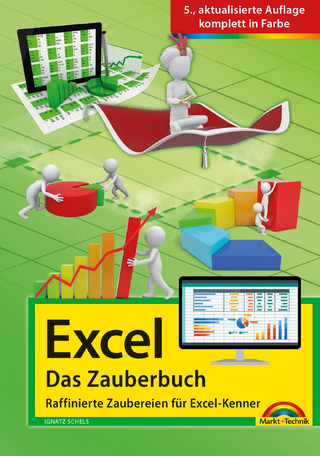
Introduction to Quantitative Methods in Business
John Wiley & Sons Inc (Verlag)
978-1-119-22097-8 (ISBN)
Featuring quantitative techniques essential for modeling modern business situations, Introduction to Quantitative Methods in Business: With Applications Using Microsoft® Office Excel® provides guidance to assessing real-world data sets using Excel. The book presents a balanced approach to the mathematical tools and techniques with applications used in the areas of business, finance, economics, marketing, and operations.
The authors begin by establishing a solid foundation of basic mathematics and statistics before moving on to more advanced concepts. The first part of the book starts by developing basic quantitative techniques such as arithmetic operations, functions and graphs, and elementary differentiations (rates of change), and integration. After a review of these techniques, the second part details both linear and nonlinear models of business activity. Extensively classroom-tested, Introduction to Quantitative Methods in Business: With Applications Using Microsoft® Office Excel® also includes:
Numerous examples and practice problems that emphasize real-world business quantitative techniques and applications
Excel-based computer software routines that explore calculations for an assortment of tasks, including graphing, formula usage, solving equations, and data analysis
End-of-chapter sections detailing the Excel applications and techniques used to address data and solutions using large data sets
A companion website that includes chapter summaries, Excel data sets, sample exams and quizzes, lecture slides, and an Instructors’ Solutions Manual
Introduction to Quantitative Methods in Business: With Applications Using Microsoft® Office Excel® is an excellent textbook for undergraduate-level courses on quantitative methods in business, economics, finance, marketing, operations, and statistics. The book is also an ideal reference for readers with little or no quantitative background who require a better understanding of basic mathematical and statistical concepts used in economics and business.
Bharat Kolluri, Ph.D., is Professor of Economics in the Department of Economics, Finance, and Insurance at the University of Hartford. A member of the American Economics Association, his research interests include econometrics, business statistics, quantitative decision making, applied macroeconomics, applied microeconomics, and corporate finance.
Michael J. Panik, Ph.D., is Professor Emeritus in the Department of Economics, Finance, and Insurance at the University of Hartford. He has served as a consultant to the Connecticut Department of Motor Vehicles as well as to a variety of health care organizations. In addition, Dr. Panik is the author of numerous books, including Growth Curve Modeling: Theory and Applications and Statistical Inference: A Short Course, both published by Wiley.
Rao N. Singamsetti, Ph.D., is Associate Professor in the Department of Economics, Finance, and Insurance at the University of Hartford. A member of the American Economics Association, his research interests include the status of war on poverty in the United States since the 1960s and forecasting foreign exchange rates using econometric methods.
Bharat Kolluri, Ph.D., is Professor of Economics in the Department of Economics, Finance, and Insurance at the University of Hartford. A member of the American Economics Association, his research interests include econometrics, business statistics, quantitative decision making, applied macroeconomics, applied microeconomics, and corporate finance. Michael J. Panik, Ph.D., is Professor Emeritus in the Department of Economics, Finance, and Insurance at the University of Hartford. He has served as a consultant to the Connecticut Department of Motor Vehicles as well as to a variety of health care organizations. In addition, Dr. Panik is the author of numerous books, including Growth Curve Modeling: Theory and Applications and Statistical Inference: A Short Course, both published by Wiley. Rao N. Singamsetti, Ph.D., is Associate Professor in the Department of Economics, Finance, and Insurance at the University of Hartford. A member of the American Economics Association, his research interests include the status of war on poverty in the United States since the 1960s and forecasting foreign exchange rates using econometric methods.
Preface xiii
1. The Mathematical Toolbox 1
1.1 Introduction 1
1.2 Linear Functions 2
1.3 Solving a Simple Linear Equation for one Unknown Variable 3
1.3.1 Solving Two Simultaneous Linear Equations for Two Unknown Variables 4
1.4 Summation Notation 6
1.5 Sets 12
1.5.1 Subset, Empty Set, Universal Set, and Complement of A Set 13
1.5.2 Intersection and Union 14
1.6 Functions and Graphs 15
1.6.1 Vertical Line Test 16
1.7 Working with Functions 17
1.7.1 Evaluating Functions 17
1.7.2 Graphing Functions 18
1.8 Differentiation and Integration 21
1.8.1 Derivative 22
1.8.2 Derivatives of Logarithmic and Exponential Functions 26
1.8.3 Higher Order Derivatives 26
1.8.4 Integration 28
1.8.5 The Definite Integral 29
1.8.6 Some Rules of Integration 31
1.9 Excel Applications 34
Chapter 1 Review 40
Eercises 41
Appendix 1.A: A Review of Basic Mathematics 45
Eercises 63
2. Applications of Linear and Nonlinear Functions 66
2.1 Introduction 66
2.2 Linear Demand and Supply Functions 66
2.3 Linear Total Cost and Total Revenue Functions 69
2.4 Market Equilibrium 71
2.5 Graphical Presentation of Equilibrium 72
2.6 Applications of Nonlinear Functions 73
2.7 Present Value of an Income Stream 78
2.8 Average Values 79
2.9 Marginal Values 80
2.10 Elasticity 81
2.11 Some Additional Business Applications 84
2.12 Excel Applications 84
Chapter 2 Review 86
Eercises 87
Excel Applications 90
3. Optimization 91
3.1 Introduction 91
3.2 Unconstrained Optimization 91
3.2.1 Models of Profit and Revenue Maximization 91
3.2.2 Solution by Trial and Error (Approximate) Method 92
3.2.3 Solution Using the Calculus Approach 93
3.2.4 Solution by Trial and Error (Approximate) Method 96
3.2.5 Solution Using the Calculus Approach 97
3.3 Models of Cost Minimization: Inventory Cost Functions and Eoq 99
3.3.1 Solution by Trial and Error Method 101
3.3.2 Solution Using the Calculus Approach 103
3.4 Constrained Optimization: Linear Programming 105
3.4.1 Linear Programming: Maximization 106
3.4.1.1 Solution by Graphical Method: First Approach 106
3.4.1.2 Solution by Graphical Method: Second Approach 109
3.4.2 Linear Programming: Minimization 114
3.5 Excel Applications 121
Chapter 3 Review 125
Chapter 3 Eercises 126
Excel Applications 130
4. What Is Business Statistics? 131
4.1 Introduction 131
4.2 Data Description 132
4.2.1 Some Important Concepts in Statistics 132
4.2.2 Scales of Data Measurement 132
4.3 Descriptive Statistics: Tabular and Graphical Techniques 134
4.4 Descriptive Statistics: Numerical Measures of Central Tendency or Location of Data 144
4.4.1 Population Mean 144
4.4.2 Sample Mean 145
4.4.3 Weighted Mean 147
4.4.4 Mean of a Frequency Distribution: Grouped Data 148
4.4.5 Geometric Mean 149
4.4.6 Median 151
4.4.7 Quantiles, Quartiles,
4.5 Descriptive Statistics: Measures of Dispersion—Variability or Spread 155
4.5.1 Range 155
4.5.2 Variance 155
4.5.3 Standard Deviation 158
4.5.4 Coefficient of Variation 160
4.5.5 Some Important Uses of the Standard Deviation 163
4.5.6 Empirical Rule 165
4.6 Measuring Skewness 166
4.7 Excel Applications 169
Chapter 4 Review 186
Eercises 188
Excel Applications 191
5. Probability and Applications 194
5.1 Introduction 194
5.2 Some Useful Definitions 195
5.3 Probability Sources 196
5.3.1 Objective Probability 196
5.3.2 Subjective Probability 196
5.4 Some Useful Definitions Involving Sets of Events in the Sample Space 197
Complement of a Given Set A 199
Mutually Exclusive Events 200
5.5 Probability Laws 200
5.5.1 General Rule of Addition 200
5.5.2 Rule of Complements 202
5.5.3 Conditional Probability 202
5.5.4 General Rule of Multiplication (Product Rule) 203
5.5.5 Independent Events 204
5.5.6 Probability Tree Approach 204
5.6 Contingency Table 208
5.7 Excel Applications 213
Chapter 5 Review 214
Eercises 215
Excel Applications 218
6. Random Variables and Probability Distributions 219
6.1 Introduction 219
6.2 Probability Distribution of a Discrete Random Variable X 220
6.3 Expected Value, Variance, and Standard Deviation of a Discrete Random Variable X 222
6.3.1 Some Basic Rules of Expectation 224
6.3.2 Some Useful Properties of Variance of X 225
6.3.3 Applications of Expected Values 225
6.4 Continuous Random Variables and Their Probability Distributions 230
6.5 A Specific Discrete Probabilty Distribution: the Binomial Case 232
6.5.1 Binomial Probability Distribution 232
6.5.2 Mean and Standard Deviation of the Binomial Random Variable 237
6.5.3 Cumulative Binomial Probability Distribution 238
6.6 Excel Applications 241
Chapter 6 Review 245
Eercises 245
Appendix 6.A 252
About the Companion Website 263
Index 265
| Erscheinungsdatum | 04.10.2016 |
|---|---|
| Verlagsort | New York |
| Sprache | englisch |
| Maße | 178 x 257 mm |
| Gewicht | 748 g |
| Themenwelt | Informatik ► Office Programme ► Excel |
| Mathematik / Informatik ► Mathematik ► Finanz- / Wirtschaftsmathematik | |
| Mathematik / Informatik ► Mathematik ► Wahrscheinlichkeit / Kombinatorik | |
| Wirtschaft ► Betriebswirtschaft / Management | |
| ISBN-10 | 1-119-22097-1 / 1119220971 |
| ISBN-13 | 978-1-119-22097-8 / 9781119220978 |
| Zustand | Neuware |
| Informationen gemäß Produktsicherheitsverordnung (GPSR) | |
| Haben Sie eine Frage zum Produkt? |
aus dem Bereich


